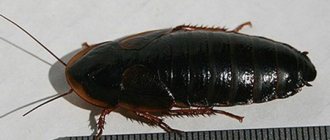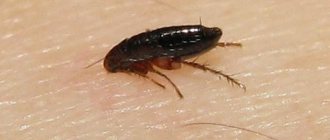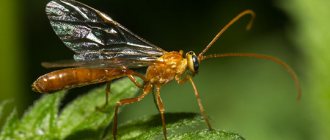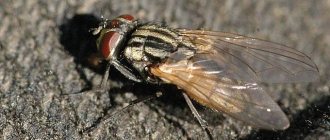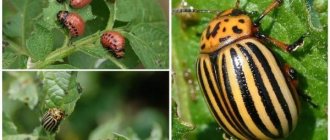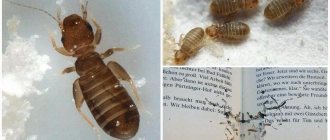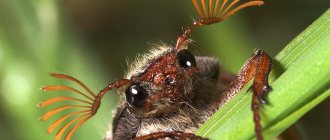Small jumping insects in the apartment, especially if you meet them even during daylight hours, and biting people and pets are fleas. None of the blood-sucking parasites that penetrate human housing are capable of jumping anymore. Conversely, other jumping insects do not bite humans.
There are about 1,000 different species of fleas in nature. Most of them parasitize certain types of animals, but if necessary, they easily change their host (for example, a cat flea can easily parasitize dogs, and a dog flea can easily parasitize cats). Cat, dog and rat fleas are so indiscriminate in choosing their prey that they “very willingly” bite humans.
Flea bites are quite painful and can cause serious allergic reactions. In addition, by constantly changing its host, this jumping blood-sucking insect can carry pathogens that are deadly to humans and animals.
Fleas are on the animal's body only during feeding, while the rest of its life is spent in warm, secluded places. In houses, such places are animal bedding, corners and crevices in the floor, where dust and fur accumulate, forming an ideal environment for the development of their eggs and larvae.
Appearance and structure of fleas
Small jumping bloodsuckers have a fairly characteristic appearance and, even despite their small size, are easily distinguished from other insects. They have a narrow, laterally flattened body 2-5 mm long. Its color is brown, almost black, the surface of the chitinous shell is smooth and shiny. Under a microscope, you can see individual spines and hairs on the flea’s body:
The legs of the last, rear pair are significantly enlarged and have powerful muscles. Thanks to them, these small insects are able to jump far, as a result of which they easily move between shelters in an apartment, and in case of danger they jump so quickly that the jump itself is not noticed by the human eye.
Fleas are the insect world record holders for jumping ability. An average individual with a body length of 3 mm can jump a distance of 30 cm, that is, 100 times its length. If humans had such abilities, it would be normal for a person to jump 160 meters in length.
The eyes of fleas are simple, almost non-functional. Fleas receive basic information about the environment using small antennas and a special sensory organ capable of detecting air vibrations.
Generally speaking, fleas are winged insects, and their lack of wings is an adaptation to a parasitic lifestyle. Without wings, it is easier for them to move in the fur and elude the teeth of their victims.
From whom and how do fleas suck blood?
Fleas are capable of feeding on a wide variety of hosts, from birds and bats to humans and cattle. Unlike other blood-sucking parasites, fleas do not have strict specialization and easily move from one host to another.
Moreover, a flea that bit a person today could have fed on a rat or dog a few days ago. And on her body, in her mouth or intestines, there may be viruses and bacteria that she collects from all her food sources.
The oral apparatus of fleas is of the piercing-sucking type; it is equipped with special bristles with which the insect easily pierces the skin. However, due to the relatively small size of the jaws, the flea is forced to literally plunge its head into the skin in order to reach a blood vessel:
Fleas feed mainly during the day, so they can easily be seen jumping around in an apartment during daylight hours. When attacked, the insect usually makes several bites at a distance of 1-2 cm from each other. Usually their traces are lined up in a chain, which is why flea bites can sometimes be confused with bedbug bites.
How dangerous are jumping bloodsuckers?
In the process of biting, the small jumping bloodsucker pierces the skin, simultaneously injecting excreta of the salivary glands under the skin, which causes irritation and itching on the victim’s body. In some cases, irritation can reach the size of an allergic reaction and is called pulicosis. In this case, the affected area involves the mucous membranes (the appearance of ulcers and abscesses), the lymphatic (swelling of the lymph nodes) and even the nervous system.
However, the greatest danger lies in the ability of fleas to carry pathogens of various diseases. Plague, encephalitis, tularemia, erysipeloid, pseudotuberculosis, brucellosis, melioidosis, pasteurellosis, anthrax, typhus - this is only a short list of diseases that a jumping blood-sucking insect can give a person.
Flea removers
Flea killers are divided into two types. The former are intended for treating animals and usually contain low concentrations of insecticides. With the help of the latter, premises are treated to completely destroy fleas, and these preparations mostly contain insecticides in fairly high concentrations, so they are not suitable for baiting fleas on pets.
Preparations for the treatment of animals are produced mainly in the following forms:
- drops on the withers - the most famous of them are Stronghold, Hartz, Bars, Frontline
- flea sprays – Hartz, Blokhnet, Advantix, Bayer
- anti-flea collars – Kiltix, Bars, Bolfo, Hartz
- flea shampoos - Lugovoy, Fitoelita, Rolf Club.
To get rid of fleas on animals with normal hair, sprays or drops are usually used on the withers. Shampoos are well suited for pets with very sensitive skin and long hair. Collars are often used not to kill insects on an already infected pet, but to protect the animal from their attack (parasites can easily jump on a cat or dog unprotected by a collar, for example, on the street).
Fleas living on animals
When treating premises, special attention is paid to dog and cat bedding, where there can be a high concentration of not only adults, but also larvae and flea eggs. Toys that pets play with are washed or washed from time to time in hot water with detergents that are safe for the animals themselves.
Anti-flea sprays justify their use before a long walk in the forest, park, or in animal walking areas, where the pet runs the risk of picking up “other people’s fleas.”
What to do if parasites are jumping in the apartment
If jumping blood-sucking insects are found in the apartment, you should follow the following sequence of actions:
- first establish the source of infection;
- then treat the animals;
- then treat the entire room.
There are usually two main sources of infection: fleas are either brought from the street by pets or family members (on clothing), or fleas themselves enter the apartment from basements and attics, where they initially parasitize rats or, less commonly, birds.
Pets should be treated in accordance with their age and health status. For young animals, as well as animals weakened by disease, specialized preparations of mild, slightly toxic action should be used.
- Shampoo gets rid of existing fleas, but does not protect against the appearance of new ones, so after bathing you should use a flea collar.
- The use of sprays requires a 2-3 hour wait after treatment, then the animal must be thoroughly washed. The residual effect of the spray allows you to do without the use of collars.
- Drops are applied pointwise to the withers, less often along the spine. They may not wash off for several days and continue to act for a long time.
After treating the animal, the main thing is to ensure its protection from fleas in the room. Otherwise, some of the jumping parasites will still end up on the fur, and after exterminating the insects in the apartment, some of them may survive on the animal.
Dog and cat bedding is subject to mandatory treatment and ventilation: a large number of adult fleas and flea eggs are concentrated in them. You can even find developing larvae - legless, worm-like, translucent creatures of a yellowish-brown color up to 4 mm in length:
The flea distribution area covers the floor and walls at waist level. Beds, wall and floor carpets, and soft toys are at risk. Insects feel at ease in warm and moist crevices, under the floor, behind the baseboard - in those places where dust accumulates the most. Under these conditions, the eggs develop quickly, and the parasites safely pass through all stages of development.
The actual treatment of the apartment from jumping insects occurs in the following sequence
- All inhabitants, including pets, are removed from the house.
- Soft items should be thoroughly vacuumed to remove dust before treatment.
- The floor surface also needs to be vacuumed and wet cleaned.
- According to the instructions, spray the drug itself.
- Leave the room in this state for several hours to consolidate the result.
- Before returning people and animals to the house, the apartment should be thoroughly ventilated and, if necessary, washed surfaces.
If there are a lot of fleas in the apartment, one treatment may not be enough. In this case, the treatment must be repeated after 2 weeks.
Methods to combat bugs
If black beetles appear in the apartment, then first you should determine their type based on external signs.
Depending on the identification, you can use various control methods to help get rid of black beetles:
- Carpet beetles and carpet pests should be combated by treating carpets and furniture; first they must be wiped with a sponge soaked in a soap solution, and then with a vinegar solution; a day after treatment, carpets and furniture should be vacuumed well, and the contents of the bag should be thrown away, as there may be insect eggs in there;
- to destroy flour beetles, it is necessary to carefully sort through all reserves of bulk products (flour, cereals, sugar, etc.); if they are found, everything must be thrown away, because they are not suitable for consumption;
- inspect the contents of all cabinets for small black or red bugs, then make a solution of 1 tbsp. l. soda per 1 liter of water and treat all surfaces and shelves inside the cabinets, wash the dishes using detergents and pour boiling water over them;
- wash all surfaces in the kitchen with a solution of acetic acid or use boric acid powder, which should be rubbed into areas where parasites may live;
- treat the floor covering and baseboards with any aerosol containing an insecticide against insects (Dichlorvos, Combat, Raid, etc.);
- clothes should be boiled or washed in hot water (not lower than +60°C).
If the measures taken do not help or there is no time to fight bugs in the apartment for a long time, then it is better to turn to professionals. There are companies that use special preparations to carry out disinfestation (extermination of pests) in any residential premises.
Fighting bugs in the house
Basement fleas: danger and specifics of control
The so-called basement fleas, which often penetrate apartments on the first floors, are the most dangerous. They often parasitize rats and can carry pathogens of serious human diseases.
It was rat fleas that caused deadly epidemics of bubonic plague in medieval Europe. Because of them, according to various estimates, up to 60 million people died over several years.
If fleas come into the apartment from the basement, then even high-quality treatment of the living space will only give a temporary effect. It is necessary to remove parasites first of all where they are most numerous - in the basement. Treating the basement yourself, especially in an apartment building, can be quite difficult, and it is more rational to call special pest control services to destroy parasites.
And finally: the most reliable protection against fleas is prevention. The main preventative measure is to protect pets from fleas on the street. Pets should not be allowed near stray dogs and cats; after a walk in the field, they should be thoroughly combed, and in the summer, collars should be put on them.
To protect the premises from fleas that penetrate here on their own, it is necessary to regularly carry out wet cleaning with the addition of wormwood decoction to the water, and hang insect repellent sections near windows and entrance doors. This will significantly reduce the risk of flea infestation.
Various types of small insects live in every house or apartment. Even if they don’t catch your eye, this does not mean they are absent. Many go out fishing only at night; the rest of the time they hide in the most remote places. These could be cracks, cavities between partitions, ventilation ducts, storerooms.
Some individuals that settle next to humans are absolutely harmless, but most bring a lot of trouble to their owners. They spoil things, food, and also bite. Many infectious diseases are also spread, therefore, having discovered the first signs of parasites in the house, you should quickly take control measures and actively get rid of intrusive guests.
Reasons for appearance
Biting parasites do not live long - about 3 months, but in a short period they manage to cause a lot of harm to animals and humans. Under unfavorable environmental conditions, parasites “freeze” for a while. When the danger disappears, fleas come out of hiding and begin to actively feed on blood, grow, and reproduce.
Parasites choose comfortable living areas, closer to the floor:
- carpets;
- torn parts of wallpaper near the baseboards;
- soft toys on the sofa;
- cracks in the floor, doors and window sill;
- pet bedding;
- floor coverings;
- loosely fitting baseboards;
- fabric decor;
- sofa cushions;
- lower shelves of cabinets;
- cluttered areas in the corners of rooms;
- boxes with old things.
How and how to clean the oven from grease and carbon deposits? Read useful information.
The rules and features of caring for a money tree at home are described on this page.
The main reasons for the appearance of parasites in the home:
- long-term lack of repairs in the apartment;
- the owners do not always change their shoes after returning home; they walk around the apartment in boots or shoes for some time;
- there is no mat near the doors: debris, dirt, larvae, insect eggs easily enter the home;
- pets go outside and bring fleas and cat fleas from their walks;
- the owners started renovations: parasites living in secluded corners got out from behind the old wallpaper and baseboards;
- pipes often burst in the basement, creating a damp zone;
- a family moving to an old house with dry wooden structures;
- insufficient cleaning of the premises, the presence of rubbish and corners where bedbugs, fleas, cockroaches, ants, and spiders can settle.
Jumping insects in the apartment - names of species
What insects can jump in the house? Among the small jumping species, especially if you encounter them during the day, fleas are very common. They look like small black dots that are constantly in motion. More than 1000 species of these bloodsuckers are known. In an apartment you can often encounter cat, dog, rat or bird fleas. As a rule, they prefer to parasitize domestic animals, but if necessary, they can easily change their host. They also do not disdain human blood.
Bites cause pain, sometimes accompanied by allergic reactions, often affecting young children. In addition, the constant change of host contributes to the transmission of dangerous pathogens of various diseases and infections. Some of them are fatal to people and pets. It is better to get rid of fleas as soon as possible, otherwise your home will be filled with entire colonies. For information on what remedies are available for insect bites for adults and children, read the article:
Jumping midges
Jumping domestic insects include different types of midges, which settle in damp, warm places and cause housewives a lot of trouble. Midges do not pose a threat to human health or life.
- Midges on indoor flowers live on stems and leaves, jump from plant to plant along the windowsill and shelves, and lay eggs in the soil. The larvae damage the roots.
- Sewer midges climb through empty pipes at night and settle in the bathroom.
- Kitchen midges appear when vegetables or fruits are stored for a long time in a warm kitchen, pantry or in long-standing garbage.
In the fight against midges, you can usually do without strong insecticides. It is enough to regularly clean the bathroom and wash the sink with cleaning products, releasing water into the drain. At night, for prevention, you can close the drain holes of the sink, bathtub and shower stall. Indoor geraniums (pelargonium) are grown on windowsills, which bloom beautifully and repel midges from themselves and neighboring plants. It is advisable to “relocate” infected plants to new soil or soil mixture by rinsing the roots in a manganese solution. The main remedy against kitchen midges is timely consumption of vegetables and fruits and removal of their remains from the premises.
In addition to jumping insects, people's companions throughout their lives are mosquitoes, flies, cockroaches, bedbugs, and spiders. Many domestic insects do not cause us any inconvenience, but their presence in the apartment is unpleasant for us, so we constantly fight them with various means.
AfterText #1
Small insects in the apartment bite and jump, how to get rid of them?
Before you start getting rid of small jumping individuals that systematically bite you, it is important to find out where they are getting into the apartment, in what places they are hiding, select a high-quality insecticide for control, and be sure to poison fleas from pets.
How to get rid of insects in an apartment - methods and means
First of all, you should treat all carpets, children's toys, upholstered furniture, and also do not forget to disinfect the walls inside the room (up to 1 m in height). Thoroughly wash all corners, niches, window sills, baseboards, using modern insecticidal preparations. Wash slippers and other textile items.
Jumping insects in the apartment cannot tolerate various pungent odors. For this purpose, vinegar, ammonia, kerosene, denatured alcohol, and chlorine-containing agents can be added to the water for washing floors. To get rid of bloodsuckers, you can also use a method based on laying out repellent plants in places where they are most concentrated. It can be:
The most effective insect repellent in the apartment
Among the most effective and popular means with which you can quickly get rid of small jumping parasites are:
- microencapsulated Get;
- Delta Zone;
- Lambda Zone;
- Executioner;
- Karbofos.
There are also traditional methods of getting rid of fleas, bedbugs, moths, ants, cockroaches and other insects in the apartment.
Small black fleas that jump on the floor in a house or apartment and painfully bite pets and people are a cause for concern. In addition to painful bites and irritating itching, black fleas are dangerous because they carry infectious diseases. Let's look at what black fleas look like, what is known about these parasites, where they come from, and how to remove black fleas from your home.
Prevention measures
To avoid dealing with fleas and prevent flea bites on yourself and your pet, you need to learn preventive measures and methods for removing fleas.
If we talk directly about cat fleas, they are very comfortable not only on cats
They also feel great close to their furry pets, and it doesn’t matter at all whether it’s a cozy apartment in a high-rise building or a hay barn in the village
The first step is protecting your pets. There are a lot of proven means for this:
- insectoacaricidal shampoos;
- flea drops;
- pills;
- anti-flea collars.
It is important to remember that fleas are removed in conjunction with deworming. Detailed recommendations on this issue can be obtained from any veterinary clinic.
The second stage of prevention is no less important. It applies to the treatment of places where pets are kept. For this purpose, a wide variety of products are also produced: repellent sprays, solutions, emulsions, liquid detergents.
Wash your cat's bedding and other favorite soft items that may contain flea eggs. If possible, steam them with a household steamer at maximum temperature and treat them with the purchased product. Wash all floors, disinfect bedspreads and carpets in the apartment.
To protect your home from the penetration of dangerous insects, it is enough to adhere to preventive measures:
Keep your home clean, paying due attention to hard-to-reach areas. Seal cracks in baseboards, window sills, and trim. Buy flea collars for your pets. After each walk, thoroughly wash and dry your pet's paws. Wash the rug lying by the front door and the dog or cat bedding as often as possible. Keep bouquets of plants in the house that repel fleas: wormwood, mint, tansy, calamus, etc. Once a month, wipe all surfaces in the house with a soda-soap solution. When going to places where parasites may accumulate, you need to dress in such a way as to block access to your body. So, if bloodsuckers do appear, you need to call specialists from sanitary and epidemiological services to fight them
So, if bloodsuckers do appear, you need to call specialists from sanitary and epidemiological services to combat them.
What do black fleas look like?
In reality, black fleas are not a separate species. Of the two thousand species of fleas known to science, the most common fleas found in homes are the cat flea (Ctenocephalides felis), the dog flea (Ctenocephalides canis), and less commonly the rat flea (Xenopsylla cheopis) and the human flea (Pulex irritans). Despite the name, fleas of each of these species parasitize different animals and freely change from one host to another.
Although they appear black in appearance from a distance, the actual color of adult fleas is dark brown. In addition, young fleas that have just emerged from their cocoons look darker, almost black, until they drink blood.
The dark coloration of hungry fleas is due to overlapping abdominal segments. As the abdomen fills with blood, it doubles in volume. The segments are distributed in such a way as not to impede this growth. As a result, after feeding, the flea's body looks lighter, since the segments no longer overlap each other.
So if little black jumping fleas have appeared in your apartment, this may mean that the parasites have emerged from cocoons that have accumulated in the carpet or floor crevices. The fact is that in the absence of animals and people, fleas freeze at the pupal stage and can live like this, waiting for a victim, for up to five months. But when they feel vibrations from their feet on the floor, they suddenly crawl out of their cocoons and, driven by hunger, go hunting.
The jumping height of these insects is 50-100 times greater than their own size, so fleas can easily jump on animals. And thanks to the hairs and bristles that cover their body, black fleas are firmly held in the fur and feathers and move deftly.
When cats and dogs become infected with fleas, black dots accumulate on their fur. These reddish-black specks are nothing more than insect feces, which represent undigested or partially digested blood of the host. These dried marks look like ground black pepper. But when moistened, the dry blood is restored and turns the water crimson-red.
Description of black flea beetles
Fleas are the collective name for many species of arthropod insects. A human black flea usually lives in the house. Despite its small size (only up to 3 cm), it has enviable jumping ability, covering a distance of up to 50 cm in one jump and reaching a height of 30 cm.
Fleas are extremely hardy and can easily withstand extreme cold and warm temperatures. But the optimal temperature for fleas is between 18 and 26 degrees. Black fleas are much more sensitive to air humidity: if it drops below 70%, then larvae will not hatch from the eggs.
How black fleas appear in the house
Adult fleas live on domestic and wild warm-blooded animals - mammals and birds, and lay eggs there. Animals in the process of life scatter flea eggs everywhere they move and rest. The emerging larvae live and feed in the environment until they develop into mature fleas.
Adult parasites enter the home from the street on the fur of pets, on wild city rats and mice, or on human clothing. Sometimes residents bring home flea eggs or larvae on their shoes along with street dust. If there are animals, fleas multiply rapidly in the apartment. Two to three weeks after an accidental infestation, the owners notice that mature young black fleas are jumping around the house, and begin to wonder what to do about this problem.
The risk of parasite infection is also associated with moving to a new place of residence, because you do not know in advance how things were with the previous residents. As a rule, new residents learn about an unwanted inheritance only when they feel black earth fleas biting their feet. But 90% of the pest population in the home is made up of invisible stages - eggs, larvae and pupae - that don't bite. And if the owners notice the infection by their bites, it means that soon the next generations of black fleas will attack them with renewed vigor.
Preventive measures
To prevent black fleas from appearing in your apartment, you need to block their entry routes:
- Regularly inspect the fur of pets, check for possible accumulation of ectoparasites on the stomach, neck and under the paws.
- Periodically treat cats and dogs with flea repellents and insecticides (Advantix, Barrier, Bars, Dana, Celandine, Frontline). Let animals go outside only wearing anti-flea collars.
- Dry bedding annually in direct sunlight.
- At least 1-3 times a quarter, carry out general cleaning with thorough cleaning and washing of all surfaces.
- Avoid dampness in the room.
- Carefully seal gaps and cracks in floors, walls and under baseboards.
You can verify the presence of parasites using a simple test: place several sheets of stationery paper in the problem area. If after a while small dark insects start jumping on it, you need to urgently start fighting them.
Previous FleasFlea drops Celandine Next FleasWhat is more effective against fleas - drops or a collar
How to get rid of black fleas in a house or apartment
Comprehensive flea control involves the destruction of all stages of the life cycle of parasites and the creation of unfavorable conditions for their reproduction. This includes chemical and physical methods of control, folk remedies, keeping the house clean and regularly treating pets.
We start with cleaning the apartment
Accumulations of dust and dirt on the floor provide a comfortable environment for the development of flea larvae. The larvae feed on the feces of adult insects and other organic debris that accumulate in carpets and house dust. The caked, contaminated top layer of carpet pile protects eggs and larvae from harmful sunlight and maintains a favorable microclimate for the development of black fleas inside the carpet.
Therefore, before proceeding with the chemical destruction of parasites, you should thoroughly clean the carpets and floor coverings, wipe off the dust and wash the floors. When washing, adding 10-20 drops of essential oil, such as lavender, peppermint or tea tree oil, to the water will act as a natural repellent to repel fleas.
Vacuuming will remove some of the flea eggs from the carpet, disturb the pupae and force them to emerge from their protective cocoons. It will also collect dirt from the surface and raise the pile, which will allow the insecticide to penetrate deep into the carpet.
We wash pet supplies, rugs and bedspreads
The highest concentration of flea eggs and larvae in the house is found on the bedding of cats and dogs, rugs and covers of upholstered furniture that animals use for rest. Cleaning these items is an essential part of your pest removal plan. We wash them in a machine or by hand at the maximum permissible temperature and dry them in a hot machine dryer.
If you have a steam cleaner, we treat with hot steam the seats, backs and armrests of upholstered furniture, crevices and cracks, soft toys, as well as floor carpets. It would be a good idea to wash the bed linen before treating the room, especially if black fleas climb onto the bed and bite at night.
Reducing relative humidity
These insects love dampness, but what small black fleas are afraid of is a dry microclimate and sunlight. We lower the relative humidity in the house using a household dehumidifier to below 50%, and after a couple of days all stages of flea growth will begin to gradually die.
To dry the eggs and larvae infesting the carpet, use ordinary finely ground salt or baking soda. It is enough to rub it into the carpet pile with a brush or broom, leave it for 3-5 days, and then vacuum it up. Another folk remedy for combating immature stages of fleas is a mixture of boric acid powder with pyrethrum, a dry herbal insecticide. This mixture is also used to treat carpets and sprinkle the floor under furniture and along baseboards.
Vacuuming carpets
As a rule, more than half of the eggs, larvae and pupae of fleas in an apartment are concentrated in carpets. First of all, new adults emerge from the carpets - young black fleas. A vacuum cleaner is an effective weapon for physically destroying the early stages of parasites. The vacuum cleaner collects eggs and larval food from the carpet - dry digested blood, which adult insects carefully secrete in abundance.
Also, the vacuum cleaner, by creating vibrations in the carpet and generating heat, imitates the presence of the victim and deceives the hidden ripe pupae to crawl out of their cocoons. Vacuuming regularly after insecticidal treatment, when carpets are dry, will have a positive effect on how quickly reappearing black fleas die from the poison. The elimination process is accelerated.
We carry out chemical treatment
Without chemicals, flea control lasts for months, and properly selected insecticides save time and effort. Because of the way the life cycle of these parasites works, a key factor in pesticide treatment is the long-lasting effect of the product. Aerosol cans such as Dichlorvos NEO or Raid kill adults quite quickly, but their effect is short-term. After 3-4 days, new parasites will appear from the carpets, and the treatment will have to be repeated again and again.
Chalk "Mashenka" and similar remedies for black fleas are also ineffective, because adult insects move mainly by jumping, and the larvae hide in carpets. Both of them are unlikely to come into contact with the drawn lines, unless you cover the floor with a layer of toxic chalk. In addition, adult fleas live in animal fur, and not on the floor.
Aqueous emulsion concentrates and suspensions based on pyrethroids, organophosphates or neonicatinoids retain an insecticidal effect on the surface for 4-6 weeks. If precautions are taken, these products are quite safe for people and animals. “Dobrokhim FOS”, “Confidant”, “Taran” and other insecticides for professional and household use after one treatment will destroy 4-5 generations of domestic black fleas.
After treatment with contact preparations, it is important to refrain from wet cleaning of the floor for at least 10-14 days. Therefore, I wash the apartment before pest control, and then make do with a vacuum cleaner and a broom.
We process animals
As mentioned above, adult fleas live on the body of animals, and if they are not treated, all the work will go down the drain. We always treat cats, dogs and other furry pets on the same day that we disinfect the premises.
Caution is required when choosing veterinary flea medications, as products for dogs, for example, can be dangerous for cats. In order not to risk the health of your beloved animals, we first consult with a veterinarian. Before using any product - collar, drops, tablets or shampoo - carefully read and follow the manufacturer's instructions.
- Author: Maria Sukhorukikh
Rate this article:
- 5
- 4
- 3
- 2
- 1
(0 votes, average: 0 out of 5)
Share with your friends!
The flea is a dangerous pest
Effective control includes compliance with the rules of agricultural technology and the use of folk and chemical means.
Compliance with the rules of agricultural technology, in combination with other control methods, will help completely destroy the pest population. Rules for caring for plantings:
- Regular removal of weeds, especially those belonging to the cruciferous family (shepherd's purse, wild radish and mustard).
- Planting plants with a flea-repelling odor in the area: tomato, garlic, nasturtium and marigolds.
- Regular watering. The flea is afraid of water and does not develop in well-moistened soil.
- Correct application of fertilizers. Healthy plants with a developed root system are easier to cope with isolated damage caused by the pest.
- Thorough digging of the soil in the autumn. This operation disinfects the soil, since all pests die from frost.
- Correct landing time. It is necessary to plant seedlings before the flea beetles become active - in early May, or between generations - in late June to mid-July.
Folk remedies are safe for plants and people and accessible. Popular remedies for cruciferous flea beetles:
- Dusting with wood ash. The procedure is carried out on a dry, windless day; you need to make sure in advance from the forecast that there will be no rain in the coming days. Pollination is carried out three times, with an interval of 4-5 days. After processing, all leaves should be covered with ash. This method is effective for seedlings.
- Decoction of tomato tops. It is prepared from 2 kg of dry or 4 kg of fresh tops and a bucket of cold water. Cooking time: 30 minutes. The strained broth should be mixed with water (1:1) and liquid soap (40 g). Plants need to be sprayed three times, with an interval of 3 days.
- An infusion of dandelion roots and leaves. Parts of the flower must be crushed (500 g) and poured into 10 liters of cold water. Leave for 2 days, strain and add 2 tbsp. l. liquid soap. Spray the plantings 2-3 times, at intervals of several days.
- Tobacco infusion. Tobacco dust (200 g) should be poured with 10 liters of boiling water and cooled completely. Then add 2 tbsp. l. liquid soap and spray the plants several times.
The only way to cope with a large flea beetle population is with the help of insecticidal preparations. These include:
- Aktara. The drug has contact-intestinal action. Effective against large colonization of the pest.
- Actellik. Non-systemic, contact-intestinal preparation based on phosphorus.
- Decis. A broad-spectrum insecticide used to control lepidopteran, coleopteran and homoptera pests.
- Inta-Vir. A contact-intestinal drug with a broad spectrum of action.
- Other drugs with similar effects: Bankol, Mospilan, Fitoverm.

